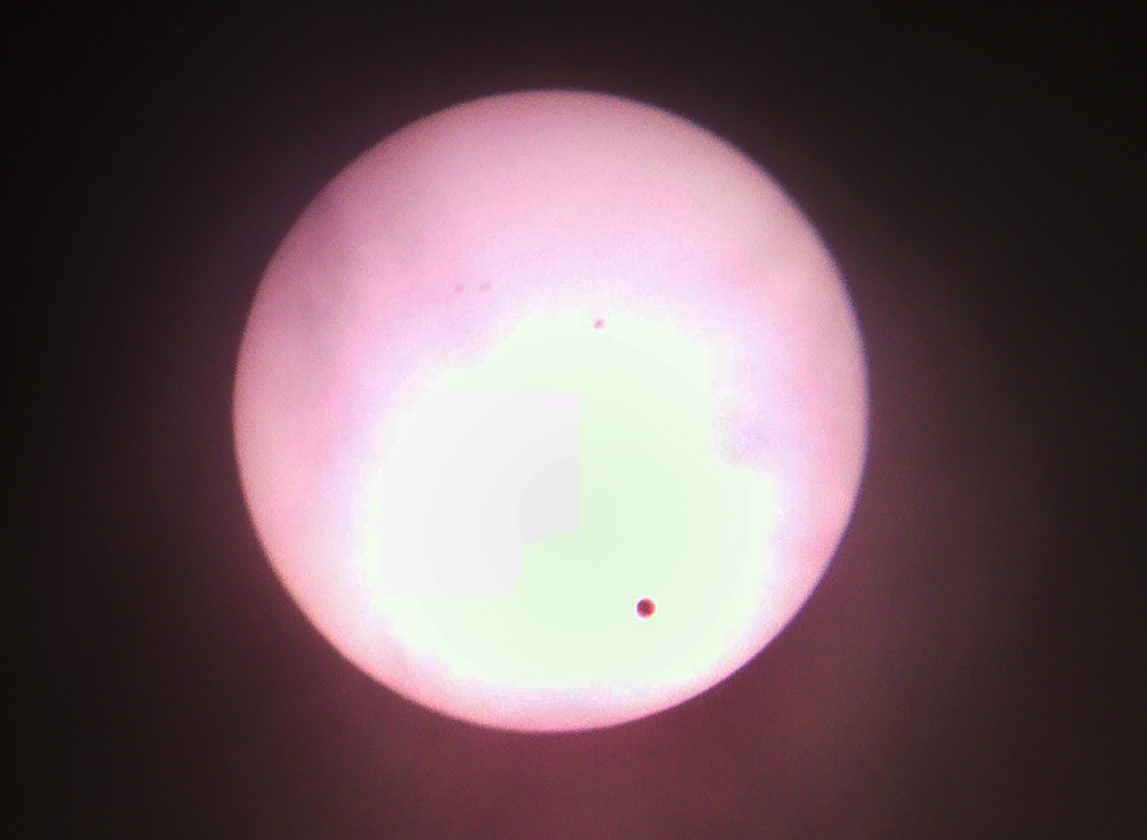Ted's Transit of Venus 2012 Page!
© 2012 Ted Saker, Jr. All Rights Reserved.
Country
of First Publication: The United States of America
These
works are for the personal viewing and enjoyment of visitors to this
site.
Any and all commercial use
of these images is absolutely, strictly and totally prohibited
without my consent.
Remember, I
sue for a living.
Page created: 6 June 2012
Tuesday, June 5, 2012, Columbus, Ohio. A major astronomical event is observable from this area: the
second of two transits of Venus occurring in the 21st century, with the
next one a mere 105.5 years in the future. I missed the first of
the pair in 2004, and I promised myself I would catch this event. I reserved a site at a park near my
home with electricity to power my imaging rig. I made solar filters
for my 6" AT6RC to photograph in white light and mounted my Coronado PST
to photograph in hydrogen alpha (deep red) light. I spent the better part of a day
testing the equipment and gauging exposure lengths.
Weather conditions are historically favorable at
this time of year, but Ohio's climate has a way of punishing
astronomers for real or imagined offenses, or is merely capricious.
This event proved once and for all that Ohio is a jealous climactic
harridan. Beautiful clear skies on June 4 gave way to waves of
clouds on the 5th, carried southwestward on the backwash of a low
pressure system that randomly developed over New England and pumped its
sky-obscuring vindictiveness right over the Buckeye State all day
long. By 3:00 PM, it was apparent that my preparations had
been a wasted effort. Packing, transportation and reassembly of
the imaging rig would not be a rewarding effort. Checking the
satellite images of Ohio, a wedge-shaped area of clear skies was
opening up and appeared to be heading my way. I decided to
minimize the gear I took and observe. If I were to image the transit, I
would have to use my phone's camera or a Kodak point-and-shoot
model.
Arriving at the site at about 5:30 PM, I found
several Columbus Astronomical Society members already set up and
waiting for first contact, predicted to occur at approximately 6:04
PM. More people joined the crowd, but the clouds stubbornly hung
on. The clear wedge lay to the west where the skies were
tantalizingly bright. At about 7:15, with the transit well
underway and sunset only about 90 minutes off, I seriously considered
relocating. Jason Hissong suggested a site in northwestern
Franklin County, about ten miles from the current location.
Although I really did not want to move, I felt that changing sites
provided the best chance of getting a view of the transit and maybe
getting a picture or two.
As I arrived at the Outerbelt, I-270, the clouds
parted and the sun shone down. Finding the new site took a bit of
doing, but the clouds stayed away. I set up my PST and Jason, his
spouse Amy, Willie Cirker, his friend, and Bill Hurley promptly arrived
and set up. Venus was well inside the solar limb by then, and we
observed for about an hour before the Sun disappeared into yet another
cloud bank about a half hour before sunset. Willie and Jason took
some amazing afocal pictures through their scopes and through my
PST. My cameras did not perform nearly as well, but I did manage
to get a few pics out of my camera phone. I consider myself
extremely fortunate, as many friends of mine in different locations
around the U.S. had worse weather conditions and missed it entirely,
except for what the web had available.
Solar system photography has always been a weak area
of my imaging expertise. Depriving myself of my main equipment hurt as
well. Yet, given the adversities encountered with this event, I
am happy to have seen it, and the images I acquired give me a good
measure of satisfaction. There have been only eight transits since
Galileo turned his telescope skyward in 1609. In view of the
technological advances over the centuries, I
can only wonder about the resources available to the generation that
will witness the next transit on December 11, 2117. I hope that
they will still have the same wonder and will not have to contend
with unfavorable environmental conditions that I experienced in my efforts to witness one of the rarest of astronomical phenomena.

|

|
Transit
of Venus, 5 June 2012 @ 0157 UT. Taken with a Kodak Easy-shoot camera
through CAS member Willie Cirker's 4.5" Newtonian in Dublin, Ohio
|
Transit of Venus, 5 June 2012 @ 0209 UT. Taken with a Kodak Easy-shoot camera through CAS member Jason Hissong's 8" Newtonian in Dublin, Ohio
|

|
The Mobile Group in Amlin, just west of Dublin
|
Return
to Main Astropix page
